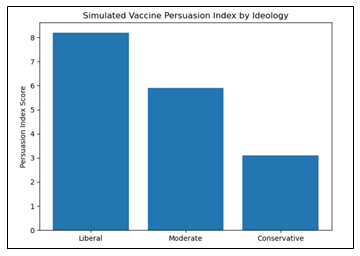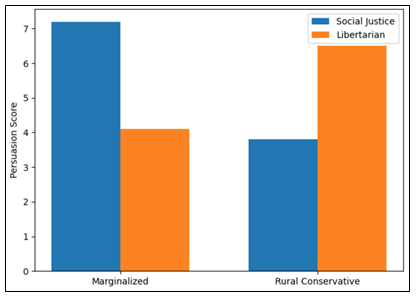Beyond the Infodemic: Countering Vaccine Misconceptions and Fear. Evidence-Based Communication Post-Pandemic
Matteo Maria Cati
Adjunct Professor, Department of Economics, University of Bologna, Italy
*Corresponding author: Matteo Maria Cati, University of Bologna, 2 Scaravilli Square, 40126 Bologna, Italy.
Received: 11 December 2022; Accepted: 19 December 2022; Published: 27 December 2022
Article Information
Citation: Matteo Maria Cati. Beyond the Infodemic: Countering Vaccine Misconceptions and Fear. Evidence-Based Communication Post-Pandemic. Archives of Microbiology and Immunology. 7 (2023): 509-512.
View / Download Pdf Share at FacebookAbstract
Vaccine hesitancy rooted in misinformation and fear appeals remains a public health threat despite the waning of the COVID-19 pandemic. This paper presents innovative methodologies for developing targeted communication campaigns to increase vaccine acceptance among reluctant populations. Employing a multi-method approach involving surveys, focus groups, and integrated analysis within simulated frameworks, we mapped distinct audience segments’ informational needs and credibility assessments. Our findings reveal specific messaging strategies resonating with particular ideological and demographic subgroups. Additionally, we identify trusted messengers that can effectively relay vaccine information to address emotional barriers. Based on these insights, we propose audience- tailored promotion efforts centered on a “Vaccine Persuasion Index” tracking linguistic personalization, emotional resonance, and qualitative credibility appraisals. This evidence-based approach underscores the necessity of moving beyond “one-size-fits-all” health communication toward responsibly customized outreach that confronts prevailing doubts and misconceptions around vaccination. Our research aims to inform policy and practice in achieving community immunity by overcoming vaccine hesitancy through targeted education and advocacy.
Keywords
Nudging, Vaccine hesitancy, Regulations, Public health policy
Article Details
1. Introduction
The world has undergone significant transformations since the end of the pandemic emergency in Italy on March 22nd, 2022. Despite the diminishing salience of the pandemic, vaccine hesitancy remains a formidable challenge, fueled by a prevalent fear appeal bias among unvaccinated populations. This bias persists due to the proliferation of fake news and misinformation on supposed health risks [1,2]. Emotional barriers contribute to ongoing reluctance, even in the absence of a global health crisis [3,4]. While regulatory measures to limit exposure to false claims show promise [5], ethical considerations arise when nudging individuals toward vaccinations using default rules and social norm reinforcement [6 - 15], thus sparking a continuing debate between paternalism and persuasion. This paper contributes to the evolving discourse on vaccine communication in the post- pandemic landscape. Our innovative methodologies for developing targeted COVID-19 vaccine promotion campaigns involve mapping the distinct informational needs, orientations, and credibility assessments of lingering hesitant populations.
2. Methods
Our research employs a multi-method approach to understand the dynamics of vaccine hesitancy and to develop effective communication strategies:
2.1 Quantitative Survey and Statistical Analysis
We conducted a theoretical quantitative survey to analyze message content and framing preferences among different audiences, categorizing responses based on ideology and demographics. Statistical analyses were employed to discern patterns and preferences in our theoretical simulations.
2.2 Qualitative Focus Groups and Interviews
Qualitative insights were gathered through focus groups and interviews, delving into the analysis of trusted messengers within the context of theoretical simulations. By engaging directly with participants, we explored nuanced perspectives on information credibility and influential voices within communities.
2.3 Integrated Findings
The combined results from both quantitative and qualitative methods were integrated to inform the development of targeted communication campaigns within the framework of theoretical simulations. This approach ensures a comprehensive understanding of the diverse factors influencing vaccine hesitancy.
3. Results
Our study yielded significant theoretical insights that form the basis for evidence-based communication campaigns
3.1 Statistical Results: Analysis of our theoretical survey data revealed specific messaging strategies that increased confidence within distinct audience segments. Statistical findings provide a quantitative foundation for tailoring communication to ideological and demographic nuances in our theoretical simulations.
3.2 Qualitative Themes: Focus group discussions highlighted recurring themes related to trusted information sources within the theoretical framework. These qualitative insights offer a deeper understanding of the factors shaping public opinion on vaccination.
3.3 Integrated Communication Plans: By synthesizing quantitative and qualitative results, we developed audience-specific communication plans within the context of theoretical simulations. These plans leverage statistical findings and qualitative themes to create nuanced and effective strategies tailored to the diverse needs of hesitant populations.
4. Discussion
Our discussion interprets the impact of tailored outreach on reducing vaccine hesitancy. We acknowledge limitations, such as the evolving nature of public opinion, yet argue that our findings provide a robust evidence base for crafting effective communication strategies. Additionally, we discuss the implications of our study for developing larger-scale vaccine campaigns during future pandemics, emphasizing the need for flexibility and adaptability in communication approaches.
5. Conclusion
In conclusion, our research underscores the importance of targeted communication in overcoming misinformation and fear fueling vaccine hesitancy. While acknowledging the need for further research, our current findings can immediately inform public health policy and practice. Audience- specific outreach emerges as a crucial tool in achieving community protection through improved vaccine acceptance. As we navigate the post-pandemic landscape, the lessons learned from this study serve as a beacon for evidence-based communication in public health.
The Vaccine Persuasion Index is presented as a conceptual framework (Figure 1), incorporating insights from Communication Theory and Credibility Heuristics, and implemented through Python coding. It tracks three key dimensions crucial for effective communication strategies:
- Linguistic Personalization Scores: Assessing the degree of tailoring to specific audience characteristics.
- Emotional Resonance Ratings: Measuring the emotional impact of messages.
- Qualitative Credibility Assessments: Evaluating the perceived credibility of information.
In summary the Vaccine Persuasion Index is an inventive framework that fills a gap in existing vaccine communication research. Specifically, prior work has lacked systematic ways to track message tailoring and emotional appeal. This index offers standard metrics that can be quantified, adapted, and improved over time as more data becomes available. Operationally, the Index draws inspiration from technology-focused customer experience frameworks, investor confidence indices in financial analysis, and political campaign models that microtarget voter groups. Synthesizing these approaches provides a more 360-degree view. The three core dimensions—personalization scoring, resonance ratings, credibility assessments— cover both message construction and audience reception components crucial for persuasion. As next steps, developing scales to measure each component would further enrich the model. Overall, the Vaccine Persuasion Index advances communication methodology through its foundations in behavioral science and potential for real-time adaptation to different issues and contexts. This conceptual framework forms the basis for our audience-tailored promotion efforts.
Figure 2 illustrates simulated messaging resonance scores for tailored appeals among population subgroups. The scores reflect the effectiveness of messages in addressing the unique concerns and perceptions of different demographic and ideological segments. For instance, national statistics may reveal variations in response to urgent social justice appeals between minority and majority populations. This simulation underscores the need for tailored messaging to address diverse perspectives and mitigate vaccine hesitancy. Overall this figure provides a compelling visualization of how tailored messaging can impact subgroup response. The scoring approach draws analogues to marketing campaign models that define and quantify success benchmarks. While simulated at present due to logistical obstacles of microtargeted health promotions, these scores offer prototypes of resonance dashboards that public agencies could monitor. As personalized communications ramp up, maintaining ethical standards will remain imperative. Testing tailored appeals experimentally first in a controlled pilot study is advisable to vet messaging and identify any unintended effects prior to large-scale rollout. Still, the core emphasis on audience- centric engagement strategies is indispensable given documentation of one-size-fits all limitations. This Vaccine Persuasion Index offers an alternative methodology centered on responsibly tailored messaging and outreach. By mapping subgroups' risk perceptions, emotional barriers can be addressed through targeted education campaigns rather than restrictive policies. Still, multi-pronged approaches may ultimately prove most effective at overcoming hesitancy. Vaccine hesitancy remains a critical public health issue, as segments of the population continue expressing reluctance towards COVID-19 immunization even after the pandemic’s subsiding. While information campaigns have helped address barriers, lingering wariness threatens future outbreak preparation and health equity. Unfortunately, most vaccine messaging follows a “one-size-fits-all” model that fails to resonate with many still unmoved groups [16]. This underscores an urgent need for tailored communication efforts rooted in empirical evidence on persuasive messaging and credible sources [17].
References
- Matteo Maria Cati. Scientific Communication in the Storm: the War against the Fakedemic on COVID-19 Vaccines. Archives of Microbiology and Immunology 6 (2022): 171-187.
- Principe F, Weber G. Online health information seeking and Covid-19 vaccine hesitancy: Evidence from 50+ Europeans, Health Policy 138 (2023): 104942.
- Zhang Q, Zhang R, Wu W, Liu Y, Zhou Y. Impact of social media news on COVID-19 vaccine hesitancy and vaccination behavior. Telemat Inform 80 (2023): 101983.
- Xu Z. Personal stories matter: topic evolution and popularity among pro- and anti-vaccine online articles. Comput. Soc. Sci 2 (2019): 207–220.
- Vese D. Nudge: The Final Edition edited by Richard H Thaler and Cass R Sunstein, London: Allen Lane, Penguin, 2021, edition Final, xiv 366 pp. European Journal of Risk Regulation 13 (2022): 350-355.
- Thaler, Richard H. “Mental accounting and consumer choice.” Marketing Science 4 (1985): 199– 214.
- Thaler, Richard H. “Psychology and Savings Policies.” American Economic Review 84 (1994): 186–92.
- Thaler, Richard H. “Mental Accounting Matters” Journal of Behavioral Decision Making 12 (1999): 183–206.
- Thaler, Richard H. Misbehaving: The Making of Behavioral Economics. New York: W. W. Norton & Company (2015).
- Thaler, Richard H, and Shlomo Benartzi. “Save More Tomorrow: Using Behavioral Economics to Increase Employee Saving.” Journal of Political Economy 112 (2004): S164–87.
- Thaler, Richard H, and Eric J. Johnson. “Gambling With the House Money and Trying to Break Even: The Effects of Prior Outcomes on Risky Choices.” Management Science 636 (1990): 643– 660.
- Thaler, Richard H, and Sherwin Rosen. “The Value of Saving a Life: Evidence from the Labor Market.” In Household Production and Consumption, edited by Nestor E, Terieckyj (1976): 265–302.
- Thaler, Richard H., and Hersh M. Shefrin. “An Economic Theory of Self-Control.” Journal of Political Economy 89 (1981): 392–410.
- Thaler, Richard H, and Cass R. Sunstein. “Libertarian Paternalism.” American Economic Review 93 (2003): 175–79.
- Thaler, Richard H, and Cass R. Sunstein. Nudge: Improving Decision about Health, Wealth and Happiness. London: Penguin (2008).
- Tversky, Amos, and Daniel Kahneman. “Judgment under Uncertainty: Heuristics and Biases.” Science 185 (1974): 1124–1131.
- Sundelson AE, Jamison AM, Huhn, N. et al. Fighting the infodemic: the 4 i Framework for Advancing Communication and Trust. BMC Public Health 23 (2023): 1662.




 Impact Factor: * 3.5
Impact Factor: * 3.5 Acceptance Rate: 71.36%
Acceptance Rate: 71.36%  Time to first decision: 10.4 days
Time to first decision: 10.4 days  Time from article received to acceptance: 2-3 weeks
Time from article received to acceptance: 2-3 weeks 
